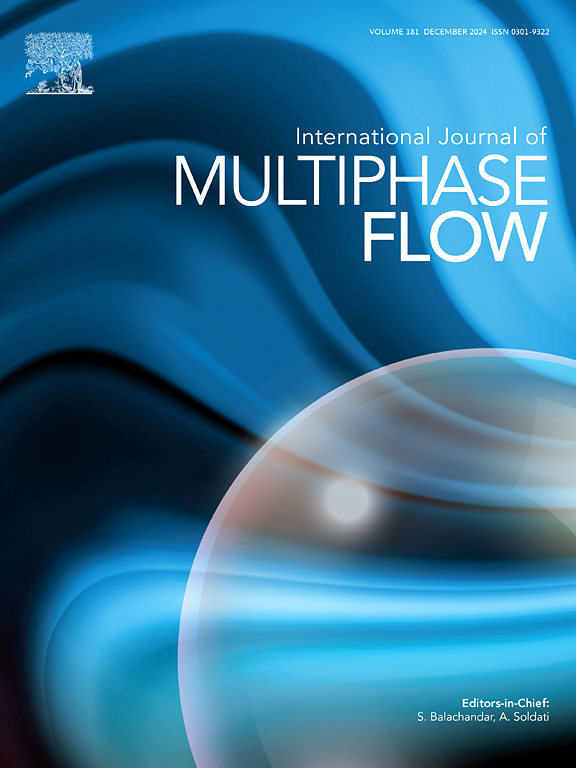Spectral analysis of preferential concentration in turbulent flows: parametric dependence on Reynolds, stokes, and froude numbers
IF 3.6
2区 工程技术
Q1 MECHANICS
International Journal of Multiphase Flow
Pub Date : 2025-03-19
DOI:10.1016/j.ijmultiphaseflow.2025.105222
引用次数: 0
Abstract
Understanding the preferential concentration of inertial particles in turbulent flows is crucial for a wide range of natural and industrial processes. This study advances our understanding of turbulence-particle interactions by systematically evaluating the combined effects of turbulent Reynolds number (Reλ), Stokes number (Stk), and Froude number (Fr) on particle clustering through direct numerical simulations (DNS). Our analysis demonstrates that particle clustering intensity peaks at Stk ∼ 1, where particles optimally interact with turbulent eddies. While previous research often overlooks the influence of Reynolds number, our findings reveal that this assumption holds for small Stk, but for larger Stk, Reynolds number significantly impacts clustering behaviour. Gravitational effects, quantified by Fr, also play a critical role in clustering dynamics. For Stk << 1, gravity's impact is minimal for Fr < 5.0; however, as Stk increases, gravity enhances large-scale clustering and modulates small-scale clustering—diminishing it for intermediate Stk ∼ 1 and enhancing it for Stk >> 1. Here, large-scale clustering refers to particle clustering at scales comparable to the largest energy-containing eddies, while small-scale clustering involves particle clustering at the dissipative scales of turbulence. We introduce a novel empirical model that predicts particle concentration spectra within 12 % relative error across a wide range of conditions validated against current and previous studies. This model provides a practical tool for analysing particle-laden turbulent flows in large spaces and has substantial implications for atmospheric science, chemical engineering, and environmental studies, offering improved predictions of droplet clustering in clouds, particulate dispersion in reactors, and pollutant transport.

湍流中优先浓度的谱分析:参数依赖于雷诺、斯托克斯和弗劳德数
了解惯性粒子在湍流中的优先浓度对于广泛的自然和工业过程是至关重要的。本研究通过直接数值模拟(DNS)系统地评估了湍流雷诺数(Reλ)、斯托克斯数(Stk)和弗劳德数(Fr)对粒子聚类的综合影响,从而加深了我们对湍流-粒子相互作用的理解。我们的分析表明,粒子聚集强度在Stk ~ 1处达到峰值,在这里粒子与湍流涡流相互作用最佳。虽然以前的研究往往忽略了雷诺数的影响,但我们的研究结果表明,这种假设适用于较小的Stk,但对于较大的Stk,雷诺数显著影响聚类行为。由Fr量化的引力效应在聚类动力学中也起着关键作用。对于Stk <;<;1、重力对Fr <的影响最小;5.0;然而,随着Stk的增加,重力增强了大尺度聚类并调节了小尺度聚类——中间Stk ~ 1的聚类减弱,Stk >>;1. 这里,大规模聚类是指粒子在与最大含能涡流相当尺度上的聚类,而小规模聚类是指粒子在湍流耗散尺度上的聚类。我们引入了一种新的经验模型,该模型在广泛的条件下(0.1≤Stk≤5.0;57≤Re≤111;0.0≤Fr≤5.0)预测颗粒浓度谱的相对误差在12%以内,并根据当前和先前的研究进行了验证。该模型为分析大空间中充满颗粒的湍流提供了实用工具,并对大气科学、化学工程和环境研究具有重大意义,提供了对云中的液滴聚集、反应堆中的颗粒分散和污染物运输的改进预测。
本文章由计算机程序翻译,如有差异,请以英文原文为准。
求助全文
约1分钟内获得全文
求助全文
来源期刊
CiteScore
7.30
自引率
10.50%
发文量
244
审稿时长
4 months
期刊介绍:
The International Journal of Multiphase Flow publishes analytical, numerical and experimental articles of lasting interest. The scope of the journal includes all aspects of mass, momentum and energy exchange phenomena among different phases such as occur in disperse flows, gas–liquid and liquid–liquid flows, flows in porous media, boiling, granular flows and others.
The journal publishes full papers, brief communications and conference announcements.

 求助内容:
求助内容: 应助结果提醒方式:
应助结果提醒方式:


